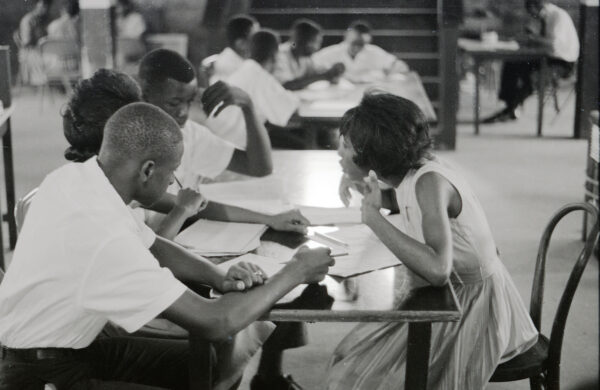
Young, Gifted, and Black: Student Organizing and the Civil Rights Movement
Learn how students were the driving force behind much of the Civil Rights Movement of the 1960s through music, interviews, and more.
April 13, 1955
14-year-old Emmet Till is lynched in Money, Mississippi after he allegedly whistled at a white woman. His mother chose to have his mutated body viewed in an open casket. Jet magazine, a leading Black publication, published the picture outraging people nationwide. An all-white jury declared his murderers innocent after minimal deliberation.
Fall 1959
Reverend Jim Lawson began to lead workshops on how to conduct a non-violent protest at Fisk University. His teaching was largely based on the works of Gandhi in Civil Disobedience in Colonial India.
February 1, 1960
Students from North Carolina Agricultural and Technical State College held a sit-in at a segregated Woolworth’s lunch counter as means of protest sparking student-led sit-ins across the country.
April 15, 1960
The Student Nonviolent Coordinating Committee (SNCC) was founded during a conference in Raleigh, North Carolina where student activists from a range of colleges and universities plus leaders from several other civil rights organizations had gathered.
February 6, 1961
Following arrests at a sit-in in Rock Hill, South Carolina, protestors refused to post bail as a statement against the immorality of segregationist laws.
May 4, 1961
Thirteen activists board a bus in Washington, D.C. headed for the deep South.
May 14, 1961
Students, both Black and white, from around the country traveling south to challenge segregated interstate bus travel. On May 14, their bus was firebombed and there were many serious injuries. On May 17, Diane Nash and other SNCC leaders continued the Freedom Rides that were originally started by CORE (Congress for Racial Equality).
July 1961
Bob Moses travels to McComb, Mississippi to begin establishing connections with the local community in preparation for a major voter registration push.
April 1962
The Voter Education Project (VEP) was created to distribute $870,000 in grant funds intended to support voter registration work in the South.
June 12, 1963
Medgar Evers, field secretary for the NAACP in Mississippi, was a mentor and inspiration for many SNCC members. His fight for voter rights began when he was prevented from voting after returning from service overseas in World War II. Evers was shot in his driveway after returning from a rally at New Jerusalem Baptist Church.
August 28, 1963
John Lewis, SNCC’s chair, was on the program to speak at the March of Washington for Jobs and Freedom. SNCC had submitted the speech Lewis was to present, but it was deemed too radical by the March’s leadership. After much discussion, the language was toned down, but SNCC’s criticism of the Federal government and their demand for stronger action remained.
April 1964
James W. Wright, Fannie Lou Hamer, Ella Baker, and Bob Moses found the Mississippi Freedom Democratic Party (MFDP) when segregationists in the traditional Democratic Party prevented Black voters from casting a ballot in the primary.
Summer 1964
Over 700 volunteers flock to Mississippi to help register and educate Black voters. These volunteers were met with violent resistance from segregationist residents who resented their presence and disagreed with their mission.
June 21, 1964
James Chaney, Andrew Goodman, and Michael Schwerner were arrested for speeding following a meeting with Black residents whose church had recently been burned down. They were held at the local jail only briefly before being released. Soon after the three hit the road, they were pulled over again and members of the Ku Klux Klan, the Neshoba County Sherriff’s Office, and the Philadelphia, Mississippi Police Department kidnapped, murdered, and then buried Chaney, Goodman, and Schwerner in an earthen dam.
March 7, 1965
Marchers in Selma, Alabama were beaten and gassed as they attempted to cross the Edmund Pettus Bridge. The presence of multiple members of the media did not deter Sherriff Jim Clark from sending police offers straight into the crowd to attack marchers. That night, footage of the Nuremburg Trials was interrupted to show footage of the violence on national television.
March 1965
Following the violence in Selma, SNCC organizers head to Lowndes County, where 80% of residents were Black, to begin a county-wide voter registration drive.
1965
Local organizers, with the help of SNCC members, formed the Lowndes County Freedom Organization (LCFO) and chose a black panther as the logo that would represent their new group on the ballot.
April 1966
By 1966 the LCFO had gained enough registered voters to register as an official political party, the Lowndes County Freedom Party (LCFP.)
Featured in

Learn how students were the driving force behind much of the Civil Rights Movement of the 1960s through music, interviews, and more.